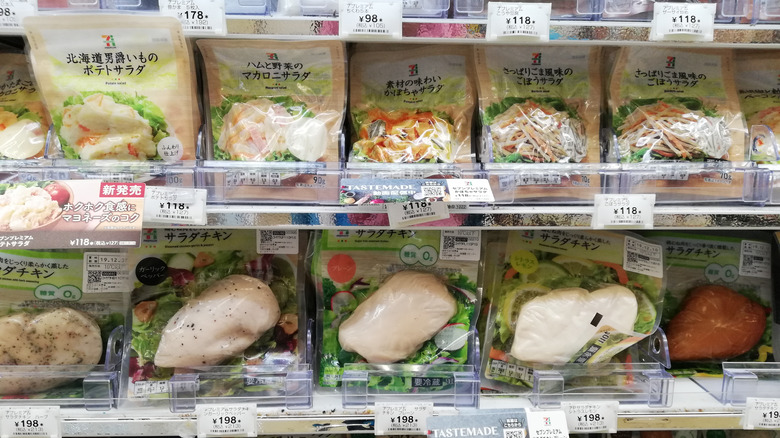Tamago Sando Is Japan's Pure And Simple Take On An Egg Sandwich
Your adventures across Shinjuku have left your stomach rumbling, and a familiar sight — the iconic green-and-red sign of a 7-Eleven konbini (or convenience store) — offers a momentary refuge. Entering the konbini, you discover an impressive array of pre-packaged foods, each promising a quick, tasty bite of Japan's myriad flavors. But one particular item beckons your attention: the tamago sando (or egg sandwich). On the shelf, this simple sandwich stands unassumingly. Its clear plastic wrap reveals its contents: two pristine, crustless slices of plush milk bread enveloping a creamy, yolk-tinged egg salad.
This is not just an egg sandwich; it's the tamago sando, Japan's pure and simple take on an egg sandwich. The milk bread, known as shokupan, offers a subtle sweetness, while the egg inside can vary from a rich blend of egg salad to a thick fluffy omelet to two variations of egg: egg salad plus a soft-boiled egg with a vibrant yolk in the middle. And each variant is a testament to Japan's ode to simplicity and dedication to craft and perfection. As you prepare to relish the tamago sando, you realize this sandwich is more than a convenient meal — it's a bite-sized journey into the heart of Japan's rich culinary heritage.
Tamago sando is emblematic of modern Japanese convenience culture
While the tamago sando is now a staple of modern Japanese convenience culture, its roots intertwine with Japan's rich culinary history and Western influences. Fresh eggs have long graced Japanese kitchens, whether atop ramen, cured in soy sauce and enjoyed over rice, or within tamagoyaki in sushi restaurants. The actual sandwich concept, though, is a Western import. Introduced mainly by Portuguese traders in the 16th century, bread became a staple in Japan by the Meiji era, with shokupan, a fluffy milk bread, taking center stage starting in the 1800s.
It wasn't long before Japanese people began crafting sandwiches infused with their culinary spirit. The fusion of milk bread with a range of local fillings led to uniquely Japanese-style sandwiches. Among these, the tamago sando — which married the cherished egg with this newfound bread and carb love — quickly rose in popularity. And as post-World War II Japan saw an explosion of konbinis, 24-hour convenience stores began catering to an ever-busy populace across the country, especially in the cities. Tamago sando and other sandwiches like ichigo (strawberry) and fruit sando naturally found their niche on their shelves in konbinis.
Crafting tamago sandos and variations
To make your own tamago sando at home, start with milk bread or shokupan. The eggs stand as the hero of the dish — depending on your sandwich rendition, scramble, boil, or transform the eggs into a delicate and fluffy omelet. For an egg salad, introduce a dash of creaminess with kewpie or Japanese mayonnaise to the hard-boiled and chopped eggs. (Kewpie mayo is richer and tangier than its Western counterpart and is available in a vegan variation.) Seasonings, typically just salt and pepper, sometimes have a hint of mustard or sugar to tune the filling's flavor profile finely. And for those leaning toward the omelet variation, lightly whisk, season, and cook eggs in a rectangular pan to achieve a delicately layered effect.
Once the chosen filling is prepared, spread it generously between two slices of shokupan. Trim off all the bread crusts to present a neat and inviting yet simple masterpiece. Modern and trendy interpretations of the tamago sando have seen innovative additions, such as green onions, ham, or a luscious and oozing soft-boiled egg nestled in the center and covered with egg salad.
In today's digital age, where food aesthetics matter, the tamago sando's photogenic nature has made it a social media favorite. Yet regardless of its form, every tamago sando embodies Japan's culinary ethos — where tradition meets innovation, and every bite echoes convenience, simplicity, quality, and ultimately, deliciousness.


